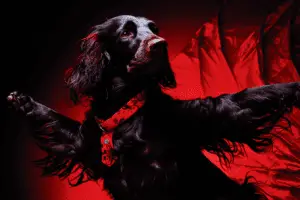It’s normal for dogs to shed, but seeing clumps of dog hair falling out is always a reason to take decisive action. Allergies are a common reason for clumps of dog hair falling out, but it is important to determine the precise cause of canine alopecia to find the best treatment. In this article, we will tell you what you need to know to help your beloved pet achieve a healthy coat.
When Do I Need to Be Concerned About My Dog’s Hair Loss?
Unless your dog is a Jonangi, a Hairless Khala, an American Hairless Terrier, a Pila, or a Mexican Xoloitzcuintle, there will be at least a modest amount of shedding.
Dogs renew their coats by losing individual hairs. Some breeds like Siberian Huskies “blow their coats” twice a year to create new insulation against both winter cold and summer heat. Other dogs like Labs, Corgis, and Sheepdogs seem to shed 24/7/365, but they feel good and look great with regular grooming.
The kind of shedding that should make every canine pet parent feel concerned is so much hair falling out that your dog has bald spots, where the skin is showing. When big clumps of dull hair fall out easily, or you can see patches of your dog’s bare skin, intervention is required.
The most common causes of canine hair loss are flea allergies, food allergies, and contact allergies. The allergy just causes an itch. When your dog scratches, licks, or rubs itchy skin to make the sensation stop, hair comes out.
Controlling allergies usually stops excessive canine hair loss. But there are other, less common causes of clumps of dog hair falling out that owners and their vets can address.
How to Recognize Hair Loss Caused By Flea Allergies in Dogs
Dogs can be extremely allergic to fleas. Insensitive dogs, it only takes one flea bite to trigger an allergic reaction. Exposure to the flea’s saliva triggers an overreaction in your dog’s immune system that can continue for weeks after all the fleas in your dog’s coat and in your home are dead.
When fleas cause itching, dogs attempt to remove them by biting their skin. They attempt to lick them off their skin. They relieve the itch by rubbing against door frames, upholstery, trees, and shrubs.
Fleas don’t usually hang out in dog hair. These tiny insects feed on dog blood for a few minutes, up to a few hours, and then hop or fly away.
If you see fleas on your dog’s skin, this usually means that your dog has a severe infestation. A cleansing bath and shampoo are called for. (Be careful not to get the fleas on yourself.) Bedding and blankets need to be sent through the washer and dryer. (But hold back one toy or blanket that you just run through the dryer so your dog will have an object with a familiar scent.) Then you need to be very careful to give your dog monthly oral or topical flea treatment.
Any dog of any breed or of mixed breeds can develop a flea allergy. Long-haired dogs are especially vulnerable.
How to Recognize Hair Loss Caused By Food Allergies in Dogs
Food allergies cause itchy skin. When dogs scratch themselves or try to lick the itch away, they lose clumps of hair.
There is an easy way to tell the difference between hair loss caused by flea allergies and hair loss caused by food allergies:
Flea allergies are most common in puppies. Food allergies usually aren’t a major problem until your dog is at least a year old.
The trigger for a food allergy is always a food ingredient your dog eats on a regular basis. Dogs don’t get food allergies the first time they try something new. Hypoallergenic dog food, the kind that requires a prescription from a vet, will stop this kind of hair loss in just a couple of weeks. You can also put your dog on an elimination diet to identify the problem food and never, ever give your dog that food again.
But treating food allergies isn’t enough when fleas are present.
How to Recognize Hair Loss from Contact Allergies in Dogs
Dogs can have many of the same allergies as people. They can be allergic to pollen. They can be allergic to household cleaners. They can have nickel allergies.
Canine hair loss can result from contact dermatitis. The remedy for this kind of hair loss for your dog is to keep your home very clean and to make sure your dog stays out of problem plants and away from the chemicals you use in your home and in your yard.
What About Other Causes of Clumpy Hair Loss in Dogs?
Allergies are the most common cause of clumpy hair loss in dogs, but they are far from the only cause of hair loss in dogs. Here are some very common concerns of pet parents observing dog hair falling out in clumps.
Small Clumps of Hair Falling Out of Dog
When your dog’s hair loss seems to be localized, and there are only small clumps of hair falling out of your dog’s coat, look for folliculitis. This condition is a bacterial infection of a hair follicle. It is a lot like an infected pimple in humans. There will be a raised red bump in the middle of the bald spot. Hair falls out around it as your dog scratches to relieve itching and pain. Antibiotic treatment usually takes care of this problem.
Dog Hair Coming Out in Small Clumps with Scabs
Your dog’s skin will form a scab as it heals from bacterial folliculitis, mentioned above. You may not even know your dog has had folliculitis until it begins to heal if it is a long-haired breed. This condition is easier to spot on short-haired dogs.
Make sure the area does not get reinfected and apply antibiotics immediately if your dog scratches and breaks the skin. Usually, lost hair grows back.
Senior Dog Losing Clumps of Hair
Senior dogs may start losing clumps of hair due to treatable illnesses such as bacterial infections of the skin and hair follicles, mange mites, and ringworm. Hair loss with reddened skin, pus, and broken skin are a cue to seek veterinary treatment right away.
Dog Losing Clumps of Hair on Hips
Hair loss on the hips and rump is usually caused by flea allergy. Flea treatment may be all your dog needs to get over the allergy.
Dog Losing Clumps of Hair Around Elbows
Hair loss around a dog’s elbows is most commonly caused by pressure sores. Older dogs spend a lot of time propping themselves up on their elbows on hard surfaces. The skin becomes hard and callused, and no longer supports the growth of hair.
Giving your dog a comfortable, soft place to lie down and regularly applying moisturizer to dry skin helps heal pressure sores. If dry, hard skin becomes cracked, be sure to apply antibiotic cream.
Hair Loss in Dogs, No Itching
Dogs can develop an autoimmune condition called alopecia areata. It’s normal for individual hairs of your dog’s coat to fall out either more or less constantly, or a couple of times a year. In alopecia areata, hair follicles fail to generate new hairs once old hairs fall out, so your dog loses more and more of her coat.
Alopecia areata usually doesn’t cause all-over hair loss. It causes patchy hair loss, in clumps, especially on the face, the ears, and the hips. This condition is treatable but may require putting your dog on steroids for a time.
Dog Losing Clumps of Hair, Cancer
One of the more common kinds of cancer in dogs is a condition called lymphoma. Sometimes this kind of cancer is confined to the skin, and sometimes hair loss is a sign that the cancer is in the dog’s bloodstream.
Hair loss is never the only symptom of cutaneous lymphoma. There will also be lumps, ulcers, scaly patches of skin, and/or redness. The skin may begin to ooze. Veterinarians have had some success treating this form of canine cancer with chemotherapy. A diet rich in omega-3 essential fatty acids like those in salmon may help to reduce inflammation and itching.
Dog Losing Clumps of Hair After Clipping for Surgery
Dogs of all breeds have to be clipped at the vet’s office before surgery. Some breeds of dogs with dense coats, such as Alaskan Malamutes, Siberian Huskies, and Keeshonds, will lose hair in clumps around the area that is clipped. This can be due to the dog’s attempt to relieve pain at the incision site, missing the regrowth cycle after the dog’s semiannual shed. The only thing to do is to wait patiently for the hair to grow back.
When Do I Need to Go to the Vet Because of Clumps of Dog Hair Falling Out?
Dogs need veterinary care when they are itchy, their hair loss is accompanied by a foul odour, they have obviously infected skin, or when hair loss is accompanied by major changes in behaviour. Always seek veterinary care when the problem seems to be spreading to other pets and people in the household.


